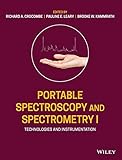Portable spectroscopy and spectrometry / edited by Richard A. Crocombe, Pauline E. Leary, Brooke W. Kammrath.
Material type: TextPublication details: Chichester: Wiley, c2021.Edition: 1st edDescription: xxi,580p.: ill.; 26 cmISBN:
TextPublication details: Chichester: Wiley, c2021.Edition: 1st edDescription: xxi,580p.: ill.; 26 cmISBN: - 9781119636366
- 9781119636403
- 621.36/1 23
- QC373.S7 P67 2021
| Item type | Current library | Collection | Call number | Status | Date due | Barcode | |
|---|---|---|---|---|---|---|---|
 Books
Books
|
Zetech Library - TRC General Stacks | Non-fiction | QC373 .C76 2021 (Browse shelf(Opens below)) | Available | Z011843 |
Includes bibliographical references and indexes.
[Volume 1] "In this book, we regard a portable spectrometer as an analytical instrument, which generates clear answers for its operator, when it is carried to the sample, i.e., spectrometer to the sample rather than sample to the spectrometer. The instrument ideally will operate in point-and-shoot mode, or at least minimize sampling handling, and the primary output is not a spectrum but rather a result. In some cases, the result might be a sample identification; in others it may be a pass/fail visual or audible alarm (green light/red light). The operators of these instruments are rarely scientists, but may instead be hazardous-material technicians, armed-services personnel, or even scrap-metal dealers. These spectrometers may have to conform to regulatory standards such as Title 21 CFR Part 11, which governs electronic records and signatures within the pharmaceutical industry in the United States, or legal standards for the admissibility of scientific evidence, such as Daubert and Frye, (1) (2) which govern the admissibility of scientific evidence in all United States Courts. The environments within which they may be used can be life threatening, such as when dealing with improvised explosive devices (IEDs), to analyze suspicious white powders, during kinetic military action, or chemical spills. When performing analytical testing in these situations, reliable rapid results that are easy for the operator to interpret understand and act on are critical."--
[Volume 2] "As described in Volume 1 of this book, we regard a portable spectrometer as an analytical instrument which generates clear answers for its operator when it is carried to the sample, i.e., spectrometer to the sample, rather than sample to the spectrometer. The operators of these instruments are rarely scientists, although that is advantageous for several applications, but instead may be hazardous-material technicians, armed-services personnel, or even scrap-metal dealers. In many instances, level-A personnel protective equipment (PPE) must be worn during the analysis."--
There are no comments on this title.

